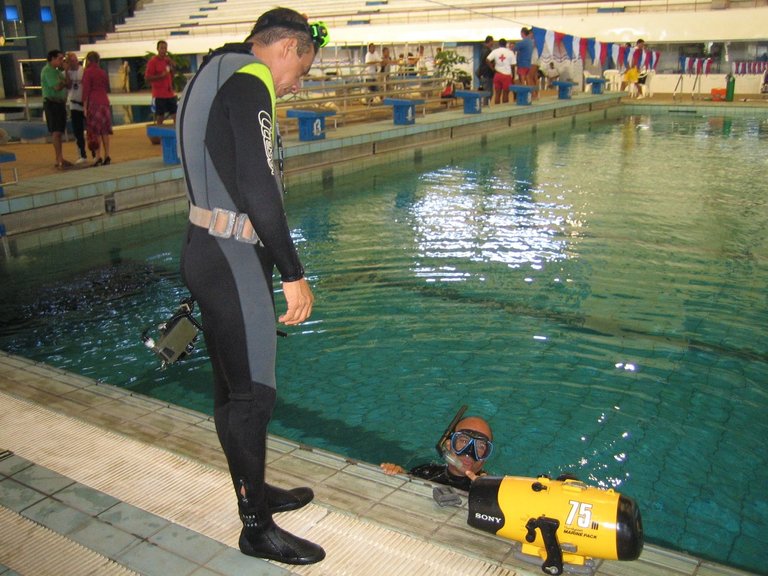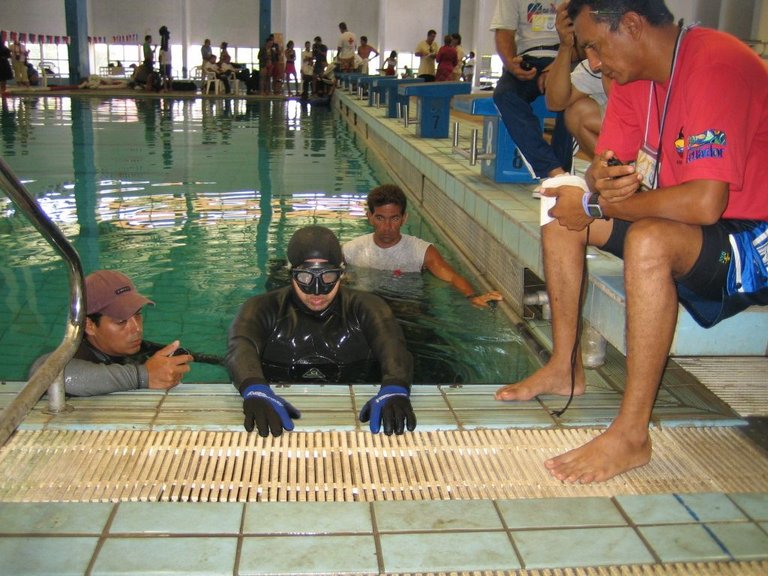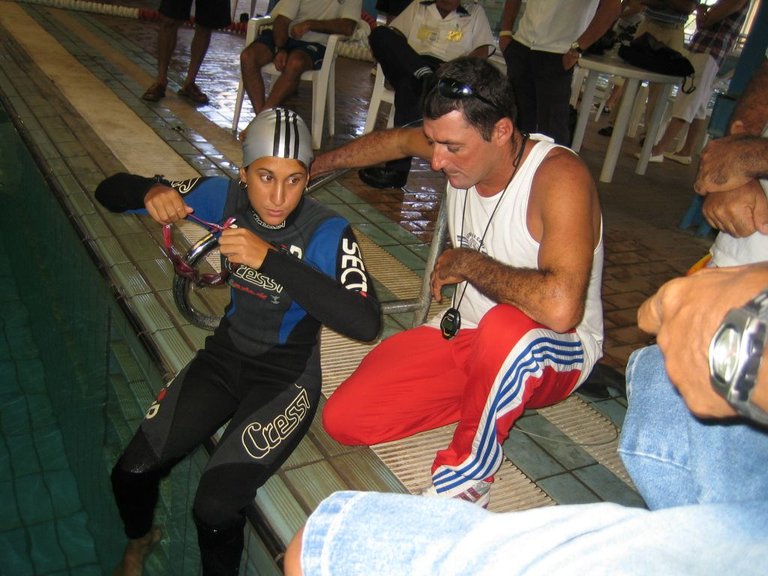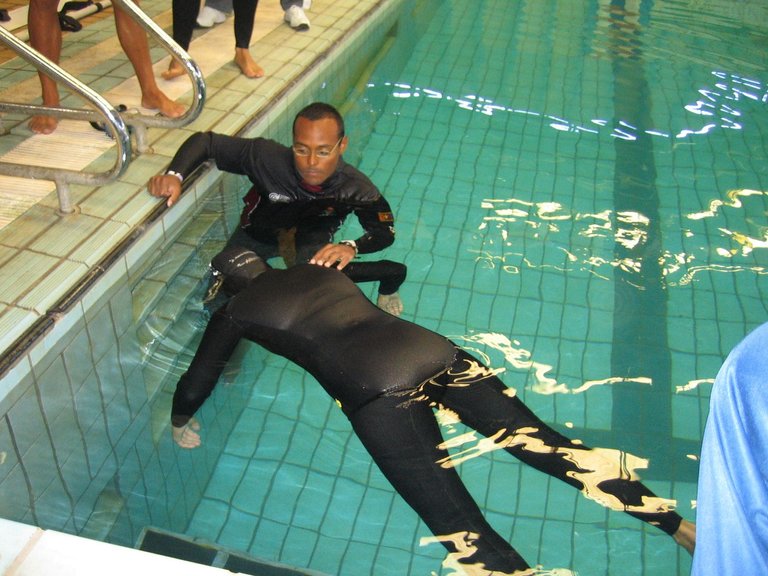
Cuando el hombre se encuentra en un medio líquido, sea en el mar, piscina, ríos o lagos, su cuerpo pierde calor por diferentes vías. Si no se protege con algún medio de protección, la hipotermia lo llevará a la muerte en poco tiempo.
Somos seres homeotermos, que mantenemos la temperatura interna a cifras relativamente constantes, 37 °C a nivel rectal, independientemente de la temperatura ambiental que exista.
Pero eso está limitado en el tiempo. Los buzos y deportistas de la apnea generalmente suelen usar algún medio de protección para evitar la hipotermia. Trajes de buceo que se escogen de acuerdo con la temperatura promedio del agua, y con las condiciones ambientales del día, en que realizarán su actividad en medio acuático.
Existen diferentes mecanismos por los cuales el cuerpo pierde calor:
Conducción: se pierde calor desde la superficie de nuestra piel caliente, al agua, que está más fría.
Convección: esa capa de agua en contacto con la piel, al calentarse, se hace más ligera y asciende; volviendo a rodear la piel, el agua circundante con la temperatura más baja.
Si el cuerpo está sin ropa, o en aguas sin movimiento, el enfriamiento ocurrirá más rápido.Evaporación: se da por vía cutánea a través de la transpiración y la sudoración.
A todos nos pasa, que cuando estamos en la playa o en una piscina, se orina mucho. Esto ocurre porque la menor temperatura del agua, produce inhibición de la hormona antidiurética.
A mayor permanencia en el agua, más pérdida de líquido por la orina, y con ella el cuerpo pierde calor corporal. Lo hará primero de las zonas periféricas, antes de afectar la temperatura central.
En la foto inicial, pueden ver a un apneísta con su monoaleta, pero porta como medio de protección la parte inferior de un traje de lycra, que le servirá para contener la pérdida de calor por su ingle, al realizar el pateo de delfín durante la modalidad de apnea dinámica.
Otros usan trajes de neopreno, los que pueden ser de diferente espesor, con capucha, guantes, y a veces hasta medias. En el tronco superior, la región axilar es otro punto de importancia donde se pierde calor.
Estos lugares específicos, también son los usados en el proceso inverso, cuando tenemos fiebre, y nuestras madres nos hacían pasar paños de agua fría o con alcohol, por la ingle y las axilas. De esa manera, se ayuda a bajar la temperatura.
El ejercicio muscular de estos atletas, favorece a que se retrase la hipotermia en un ambiente calmado, pero cuando hay agitación del agua, en un mar rizado, se perderá calor por mecanismo de convección.
Una vez que la temperatura interna baje a 35 grados, podrá la persona temblar, sentir disconfort y hasta ponerse irritable.
De 30 a 35 grados, se suma la incoordinación motora, sueño, y embotamiento de la conciencia. Una fase de depresión, que de no atenderse, llevará a la fase crítica, donde la temperatura central baja hasta los 25 grados, causando alteraciones del ritmo del corazón, con arritmias y fibrilación auricular.
Si baja aún más la temperatura, la persona caerá en coma con muerte final.
Todo esto se acrecienta, si se suman otras variables como son: ingestión de bebidas alcohólicas, uso de drogas, deshidratación celular por insuficiente aporte hídrico, el estrés, y problemas de salud.
Por eso, lo más importante será la protección térmica en medio acuático. Incluso en gran profundidad, el traje de neopreno llega a ser insuficiente, y los buzos deben usar trajes secos, sistemas con circulación de aire caliente o el uso de resistencias eléctricas.
La hidratación es un factor clave, para compensar la pérdida líquida que siempre tendremos cuando estamos en el agua por cierto tiempo.
A nivel competitivo, estos atletas estarán asegurados por todo un equipo de personas que se suman a la logística, que les garantice un buen rendimiento deportivo y en las mejores condiciones. En caso de cualquier problema de salud, siempre tendrán una atención rápida para evitar complicaciones médicas.
Espero que este post les haya resultado interesante. Gracias a los que me leyeron. Les deseo un buen inicio de semana.
Avoid dying from hypothermia in an aquatic environment

When man is in a liquid medium, whether in the sea, swimming pool, rivers or lakes, his body loses heat by different ways. If he does not protect himself with some means of protection, hypothermia will lead to death in a short time.
We are homeothermic beings, who maintain our internal temperature at a relatively constant 37 °C at rectal level, regardless of the ambient temperature.
But this is limited in time. Freedivers and divers generally use some means of protection to avoid hypothermia. Diving suits are chosen according to the average water temperature and the environmental conditions of the day in which they will perform their activity in the aquatic environment.
There are different mechanisms by which the body loses heat:
Conduction: heat is lost from the surface of our hot skin, to the water, which is cooler.
Convection: that layer of water in contact with the skin, when heated, becomes lighter and rises; returning to surround the skin, the surrounding water with the lower temperature.
If the body is unclothed, or in water without movement, cooling will occur faster.Evaporation: occurs via the skin through perspiration and sweating.
It happens to all of us that when we are at the beach or in a swimming pool, we urinate a lot. This happens because the lower water temperature causes inhibition of the antidiuretic hormone.
The longer you stay in the water, the more liquid you lose through urine, and the more your body loses body heat. It will do so first through the peripheral areas, before affecting the core temperature.
In the initial photo, you can see a freediver with his monofin, but he wears as a means of protection the lower part of a lycra suit, which will serve to contain the loss of heat through the groin, when performing the dolphin kick during the dynamic apnea mode.
Others wear neoprene suits, which can be of different thicknesses, with hood, gloves and sometimes even socks. In the upper part of the trunk, the axillary region is another important point where heat is lost.
The muscular exercise of these athletes favors the delay of hypothermia in a calm environment, but when there is agitation of the water, heat will be lost by convection mechanism.
Once the internal temperature drops to 35 degrees, the person may shiver, feel discomfort and even become irritable.
From 30 to 35 degrees, motor incoordination, sleepiness, and dulling of consciousness are added. A phase of depression, which if left unattended, will lead to the critical phase, where the core temperature drops to 25 degrees, causing heart rhythm disturbances, with arrhythmias and atrial fibrillation.
If the temperature drops even further, the person will fall into a coma with eventual death.
All this is increased if other variables are added such as: alcoholic beverage intake, drug consumption, cellular dehydration due to insufficient water intake, stress and health problems.
Therefore, the most important thing will be thermal protection in the aquatic environment. Even at great depth, the neoprene wetsuit is insufficient, and divers should use dry suits, systems with hot air circulation or the use of electric heaters.
Hydration is a key factor, to compensate for the loss of fluid that we will always have when we are in the water for a certain period of time.
At the competitive level, these athletes will be insured by a whole team of people who are added to the logistics, which will ensure a good sporting performance and in the best conditions. In case of any health problem, they will always have a quick attention to avoid medical complications.
I hope you found this post interesting. Thanks to those who read me. I wish you a good start of the week.

Separador. De uso libre por/Text divider. Free use from @eve66
Fotos propias. Cámara usada/Own photos. Camera: Canon IXUS 175
Texto por/Text by Andrés Brunet
Gracias por leer/Thank you for reading
Bienvenidos sus comentarios/Welcome your comments
¡Saludos infinitos!/Infinite greetings!





